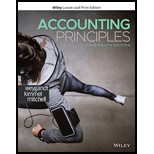
Concept explainers
(a)
Journal Entries: Entries to record the financial transactions during each accounting period are called journal entries. Income, liabilities and the giver are credited if the balance is increased and debited if the balance is reduced Expenses, assets and the receiver are debited if the balance is increased and credited if the balance is reduced in a journal entry.
To record: The July transactions in the journal entries and ledger accounts.
(b)
To prepare: The
(c)
Worksheet: A worksheet is the summary of accounting information that is prepared to ensure that the accounts are recorded correctly for financial statements preparation. It reflects the temporary and permanent account both.
To prepare: The complete worksheet of Company A at July 31.
(d)
Income Statement: Income statement is a part of financial statements. It depicts the profit or loss, a company has, in a financial year. The balances of revenues and expense accounts from trial balance are recorded in this statement.
Owners’ Equity Statement: Statement of
Classified
To prepare: The income statement, owners’ equity statement and a classified balance sheet for Company A.
(e)
Adjusting Journal Entries: Companies need to record the journal entries at the end of accounting period to apply the matching and revenue recognition principles. These journal entries are
To record: The adjusting journal
(f)
Closing Entries: Journal entries, which transfer the balances from temporary accounts to income summary or retained earnings account, are called closing entries. The revenues accounts are debited and the expenses are credited in these entries because their balances are transferred.
To record: The closing entries and post those to ledger accounts.
(g).
To prepare: The post-closing trial balance for Company A.
Trending nowThis is a popular solution!

Chapter 4 Solutions
ACCT.PRINCIPLES (LL)

 AccountingAccountingISBN:9781337272094Author:WARREN, Carl S., Reeve, James M., Duchac, Jonathan E.Publisher:Cengage Learning,
AccountingAccountingISBN:9781337272094Author:WARREN, Carl S., Reeve, James M., Duchac, Jonathan E.Publisher:Cengage Learning, Accounting Information SystemsAccountingISBN:9781337619202Author:Hall, James A.Publisher:Cengage Learning,
Accounting Information SystemsAccountingISBN:9781337619202Author:Hall, James A.Publisher:Cengage Learning, Horngren's Cost Accounting: A Managerial Emphasis...AccountingISBN:9780134475585Author:Srikant M. Datar, Madhav V. RajanPublisher:PEARSON
Horngren's Cost Accounting: A Managerial Emphasis...AccountingISBN:9780134475585Author:Srikant M. Datar, Madhav V. RajanPublisher:PEARSON Intermediate AccountingAccountingISBN:9781259722660Author:J. David Spiceland, Mark W. Nelson, Wayne M ThomasPublisher:McGraw-Hill Education
Intermediate AccountingAccountingISBN:9781259722660Author:J. David Spiceland, Mark W. Nelson, Wayne M ThomasPublisher:McGraw-Hill Education Financial and Managerial AccountingAccountingISBN:9781259726705Author:John J Wild, Ken W. Shaw, Barbara Chiappetta Fundamental Accounting PrinciplesPublisher:McGraw-Hill Education
Financial and Managerial AccountingAccountingISBN:9781259726705Author:John J Wild, Ken W. Shaw, Barbara Chiappetta Fundamental Accounting PrinciplesPublisher:McGraw-Hill Education





